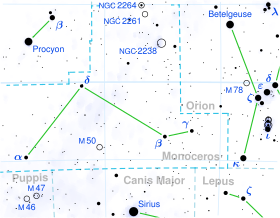
| |
| Observation data Epoch J2000 Equinox J2000 | |
|---|---|
| Constellation | Monoceros |
| Right ascension | 07 10 13.68177 |
| Declination | −04° 14′ 13.5829″ |
| Apparent magnitude (V) | 4.92 |
| Characteristics | |
| Evolutionary stage | horizontal branch |
| Spectral type | K0III |
| U−B color index | +0.78 |
| B−V color index | +1.03 |
| Astrometry | |
| Radial velocity (Rv) | +77.74 km/s |
| Proper motion (μ) | RA: −0.714 mas/yr Dec.: +217.298 mas/yr |
| Parallax (π) | 16.8419 ± 0.1692 mas |
| Distance | 194 ± 2 ly (59.4 ± 0.6 pc) |
| Absolute magnitude (MV) | 0.94 |
| Details | |
| Mass | 1.07±0.20 M☉ |
| Radius | 10.25±0.11 R☉ |
| Luminosity | 46.36±0.56 L☉ |
| Surface gravity (log g) | 2.53±0.10 cgs |
| Temperature | 4,714±46 K |
| Metallicity | −0.25±0.03 dex |
| Rotational velocity (v sin i) | 2.33±0.50 km/s |
| Age | 5.75±2.85 Gyr |
| Other designations | |
| 20 Mon, BD−04°1840, FK5 1186, GC 9477, HD 54810, HIP 34622, HR 2701, SAO 134282, CCDM J07102-0414A, WDS J07102-0414A | |
| Database references | |
| SIMBAD | data |
20 Monocerotis is a single star located about 194 light years away from the Sun in the equatorial constellation of Monoceros. It is visible to the naked eye as a faint, orange-hued star with an apparent visual magnitude of 4.92. The star is receding from the Earth with a heliocentric radial velocity of +78 km/s.
This object is an aging giant star with a stellar classification of K0 III. It is a red clump giant, which indicates it is on the horizontal branch and is generating energy through helium fusion at its core. The star is around six billion years old with 1.1 times the mass of the Sun. After exhausting the supply of hydrogen at its core, it has expanded to 10.3 times the Sun's radius. It is radiating 46 times the luminosity of the Sun from its swollen photosphere at an effective temperature of 4,714 K.
In addition to the primary, three visual companions have been reported: component B, with magnitude 12.93 and separation 67.8", C, with magnitude 10.16 and separation 167.9", and D, with magnitude 12.46 and separation 102.3".
References
- ^ Brown, A. G. A.; et al. (Gaia collaboration) (August 2018). "Gaia Data Release 2: Summary of the contents and survey properties". Astronomy & Astrophysics. 616. A1. arXiv:1804.09365. Bibcode:2018A&A...616A...1G. doi:10.1051/0004-6361/201833051. Gaia DR2 record for this source at VizieR.
- ^ Ducati, J. R. (2002). "VizieR Online Data Catalog: Catalogue of Stellar Photometry in Johnson's 11-color system". CDS/ADC Collection of Electronic Catalogues. 2237. Bibcode:2002yCat.2237....0D.
- ^ Puzeras, E.; et al. (October 2010), "High-resolution spectroscopic study of red clump stars in the Galaxy: iron-group elements", Monthly Notices of the Royal Astronomical Society, 408 (2): 1225–1232, arXiv:1006.3857, Bibcode:2010MNRAS.408.1225P, doi:10.1111/j.1365-2966.2010.17195.x, S2CID 44228180
- ^ Hoffleit, D.; Warren, W. H. (1995). "VizieR Online Data Catalog: Bright Star Catalogue, 5th Revised Ed. (Hoffleit+, 1991)". VizieR On-line Data Catalog: V/50. Originally Published in: 1964BS....C......0H. 5050. Bibcode:1995yCat.5050....0H.
- ^ Jofré, E.; Petrucci, R.; Saffe, C.; Saker, L.; Artur de la Villarmois, E.; Chavero, C.; Gómez, M.; Mauas, P. J. D. (2015). "Stellar parameters and chemical abundances of 223 evolved stars with and without planets". Astronomy & Astrophysics. 574: A50. arXiv:1410.6422. Bibcode:2015A&A...574A..50J. doi:10.1051/0004-6361/201424474. S2CID 53666931. Vizier catalog entry
- Anderson, E.; Francis, Ch. (2012). "XHIP: An extended hipparcos compilation". Astronomy Letters. 38 (5): 331. arXiv:1108.4971. Bibcode:2012AstL...38..331A. doi:10.1134/S1063773712050015. S2CID 119257644. Vizier catalog entry
- ^ Jofré, E.; et al. (2015). "Stellar parameters and chemical abundances of 223 evolved stars with and without planets". Astronomy and Astrophysics. 574: A50. arXiv:1410.6422. Bibcode:2015A&A...574A..50J. doi:10.1051/0004-6361/201424474. S2CID 53666931.
- "20 Mon". SIMBAD. Centre de données astronomiques de Strasbourg. Retrieved 2019-05-31.
- Eggleton, P. P.; Tokovinin, A. A. (2008), "A catalogue of multiplicity among bright stellar systems", Monthly Notices of the Royal Astronomical Society, 389 (2): 869, arXiv:0806.2878, Bibcode:2008MNRAS.389..869E, doi:10.1111/j.1365-2966.2008.13596.x, S2CID 14878976.
- Mason, Brian D.; Wycoff, Gary L.; Hartkopf, William I.; Douglass, Geoffrey G.; Worley, Charles E. (2001). "The 2001 US Naval Observatory Double Star CD-ROM. I. The Washington Double Star Catalog". The Astronomical Journal. 122 (6): 3466. Bibcode:2001AJ....122.3466M. doi:10.1086/323920. Vizier catalog entry
| Constellation of Monoceros | |||||||||||||
|---|---|---|---|---|---|---|---|---|---|---|---|---|---|
| Stars |
| ||||||||||||
| |||||||||||||
| Star clusters |
| ||||||||||||
| Nebulae |
| ||||||||||||
| Galaxies |
| ||||||||||||